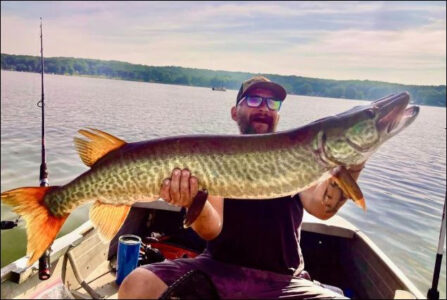Is FFS A Fishing Contest Game Changer?

Combining screens with forward-facing sonar allows navigation, GPS, depth maps and the usual forward-facing sonar elements. Photo courtesy of Forrest Fisher
I first learned Forward-Facing Sonar details from NWT pro walleye angler Dylan Nussbaum a few weeks back. He shared that during the first NWT tournament of this year in the western basin of Lake Erie, he and his dad (his pro team partner) found bigger fish by using their FFS to ONLY look for larger fish. If smaller fish were noted, they would move on and continue to look and fish elsewhere. The bow motor was usually always on, searching for big walleyes.
Last weekend, when the certified high-precision weight scales of the Western New York Walleye Classic came to rest on the Central Avenue Pier at Dunkirk Harbor, high-energy Tournament Director Josh Larsen, president of Primitive Patriots Outdoors, LLC, said, “We have a winner.”
Angler teams weighed in their six-fish bag, and the stage was filled with sheer anticipation and energy. Some anglers were more excited than others, and rightly so, as they caught heavy fish. Captain Ashton Laird, Joe Papalia and NWT angler Andy Travis took home the 2025 Classic Championship trophy and winnings for Lime Lake Marine. Their final six-fish tally was 38.06 pounds, almost 3 pounds heavier than second-place Eye-Candy and 5 pounds more than third-place Kra-Mar. These are big margins. How did they do it?
Lime Lake Marine used three FFS units that did not interfere with each other. Why? Because they were each looking in separate directions. Andy Travis used a Lowrance Active Target unit on the bow, and Laird and Papalia used Garmin Live Scope units on each side. With jigging Rapala lures, they attracted vicious strikes from the suspended walleye they spotted with their FFS sonar units.
“The fish didn’t just hit the lures; they engulfed them,” Laird said.

Forward-facing sonar identifies depth of fish in depth and in distance from the boat. Note the scale in feet at the top of the photo. Photo courtesy of Forrest Fisher
He estimated more than 150 walleyes came to the boat over the two days of the tourney. The question is, can anyone do this? With time, I think so.
But it’s not just about the technology, it’s about the skill and practice. Training and practice are required, though, and that’s what makes it so rewarding.
Laird credits Travis for him and Papalia doing so well out there, but what about other anglers? Is using FFS difficult? There are pros and cons. FFS allows precision targeting to enable focused fishing for individual walleyes. The sensitivity of the targeted fish observed with FFS is discernible in real-time. Anglers can change lure size or leader diameter to measure and see the difference in how the fish react. Quite amazing.
“We were spooking the fish with size 9 jigging Rapala lures and switched to smaller size 7s to see if it mattered,” Laird said. “It did. The difference was immediate.”
With FFS, you move around, and active fish are detected from passive fish. The depth at which some fish suspend, usually bigger fish, without trolling over them is detectable. Laird found some fish just 5 feet down in 50 feet of water. He cast to them and caught them. Trolling over them would have driven them away. So, after finding the fish, vertical jigging lures presented as a casting bait, swim jigs, or similar lures can work very well. This is only a very short summary of the pros.
For the cons, FFS only works when you find the fish. You know the old rule: 90% of the fish are in 10% of the water. That’s true on many days. Trolling can find the fish much better on big water, but conventional side-scan sonar can locate fish and then move back with FFS (if it’s calm and you can hold the boat position). Importantly, FFS is somewhat weather-sensitive, as it works better in calmer water, which is not typical on our end of Lake Erie. Rough water makes boat control challenging; a very long shaft on the bow motor with lots of energy could be required. In short, a significant learning curve is needed to use FFS effectively. Success with FFS requires developed visual interpretation skills and accurate casting to reach the fish detected on the screen.
FFS units cost between $2,000 and $5,000 and require a compatible standard sonar system and transducer with standard fishing rods and reels. Traditional trolling requires a basic downward and side-scan sonar with a navigation system, a system of rods, fishing reels with high line capacity fitted with lead core or other lines, and lures of the stick-bait and spoon sort. Add planer boards, rod trees, diving planes, and other items, such as the possible use of downriggers. What is the cost of trolling? Depending on you and your boat, it’s different for everyone, but it might be $10,000 or more.
In summary, the FFS system may seem expensive initially, but it is only costly upfront. It has lower operational costs. Trolling gear is cheaper individually but collectively adds up, especially if you run a full spread with premium equipment. With FFS, you might make a significant investment at the start, but the long-term savings could be substantial, making it a smart financial choice for serious anglers.
To catch more fish, troll with side-scan to locate schools, then switch to FFS if you want to pick off fish with jigs and soft plastics of your choice — and the lake wave height allows it.
The Walleye Classic was a calm-water tournament; in typical Lake Erie, catching fish with FFS might have been tough because of limited boat control. In early summer, the walleye schools are scattered, and trolling may be more productive. As fish concentrate toward mid-summer, FFS will likely become even more effective for targeting suspended schools of walleye, bass, and every other fish species.
In the final verdict, FFS is a game changer for skilled anglers on relatively calm waters but requires precision visual interpretation and skilled casting prowess. Trolling is more forgiving and efficient for covering a large area, and it will remain a go-to system for fishing the open water of the Eastern Basin. Top anglers will likely need to combine both for tournament success. Gimme a bobber, a worm, and my grandson — PLEASE.
Gotta love the outdoors.
CALENDAR
June 7-15: 41st annual nine-day Southtowns Walleye Tournament, $100 entry, $100k prizes; Jim Skoczylas, 716-796-5372; https://www.southtownswalleye.com/.
June 14: Teach-Me-To-Fish free fishing clinic, NYSDEC with Erie County Federation of Sportsmen, Tifft Nature Preserve, 1200 Fuhrmann Blvd., Buffalo, 9:30 a.m. to 12:30 p.m., register online: www.ecfsc.org, or call 716-533-4070.
June 14: Father’s Day Shoot, Hanover Fish & Game,100 sporting, non-registered, 780 Overhiser Road, Silver Creek; 716-934-4028
June 14: NYS Safe Boater Course, Northern Chautauqua Conservation Club, 8 a.m. to 4 p.m., register online at Https://www.register-ed.com/events/view/226928.
June 15: NYS black bass and Great Lakes musky seasons open.
June 15: Chautauqua Lake Bassmasters 2025 Father’s Day Bass Open Tournament, 6 a.m. to 2 p.m., Prendergast Boat Launch, two adults and one child allowed per boat; $100 entry includes Big Bass Payout. Tournament Director: 716-708-0330.
June 21-22: NY Musky, Chautauqua Lake Showdown, Launch site TBD, Region 3 Chapter Challenge; 585-287-7578
- Combining screens with forward-facing sonar allows navigation, GPS, depth maps and the usual forward-facing sonar elements. Photo courtesy of Forrest Fisher
- Forward-facing sonar identifies depth of fish in depth and in distance from the boat. Note the scale in feet at the top of the photo. Photo courtesy of Forrest Fisher






